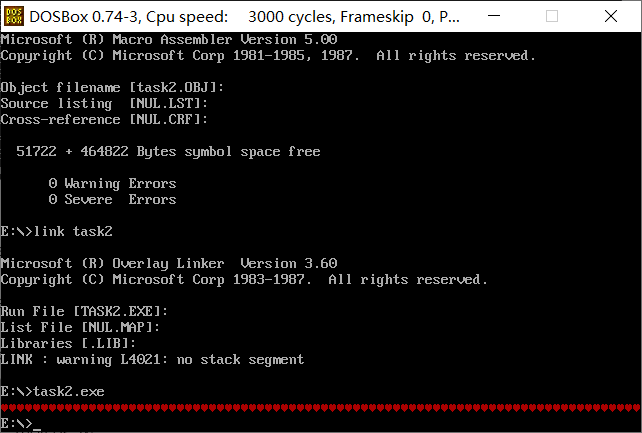Experimental task 1
Task 1-1
Source code:
assume ds:data, cs:code, ss:stack data segment db 16 dup(0) ;16 byte units are reserved, and the initial values are 0 data ends stack segment db 16 dup(0) ;16 byte units are reserved, and the initial values are 0 stack ends code segment start: mov ax, data mov ds, ax mov ax, stack mov ss, ax mov sp, 16 ;Set stack top mov ah, 4ch int 21h code ends end start
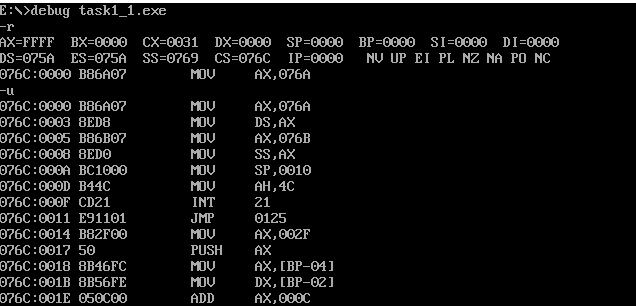

① In debug, execute until the end of line17 and before line19. Record this time: register (DS) =_ 076A_, Register (SS)=__ 076B__, Register (CS)=_ 076C_
② Assuming that the segment address of the code segment is X after the program is loaded, the segment address of the data segment is X__ X-2__, The segment address of stack is__ X-1__
Task 1-2
Source code:
assume ds:data, cs:code, ss:stack data segment db 4 dup(0) ; Four byte units are reserved, and the initial value is 0 data ends stack segment db 8 dup(0) ; 8 byte units are reserved, and the initial values are 0 stack ends code segment start: mov ax, data mov ds, ax mov ax, stack mov ss, ax mov sp, 8 ; Set stack top mov ah, 4ch int 21h code ends end start

① In debug, execute until the end of line17 and before line19. Record this time: register (DS) =__ 076A__, Register (SS)=_ 076B__, Register (CS) =__ 076C__
② Assuming that the segment address of the code segment is X after the program is loaded, the segment address of the data segment is X__ X-2__, The segment address of stack is__ X-1__.
Task 1-3
Source code:
assume ds:data, cs:code, ss:stack data segment db 20 dup(0) ; 20 byte units are reserved, and the initial values are 0 data ends stack segment db 20 dup(0) ; 20 byte units are reserved, and the initial values are 0 stack ends code segment start: mov ax, data mov ds, ax mov ax, stack mov ss, ax mov sp, 20 ; Set initial stack top mov ah, 4ch int 21h code ends end start
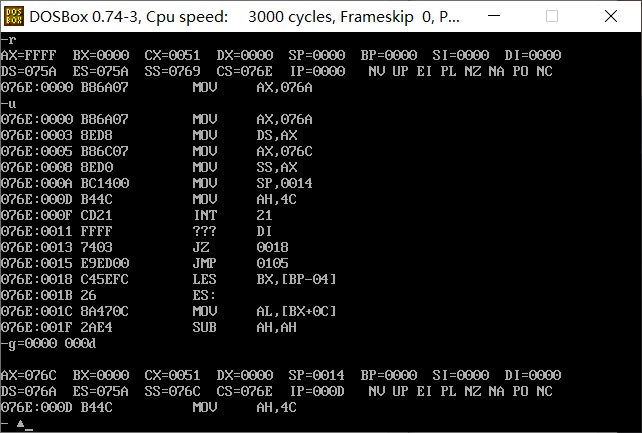
① In debug, execute until the end of line17 and before line19. Record this time: register (DS) =__ 076A_, Register (SS)=__ 076C__, Register (CS) =__ 076E__
② Assuming that the segment address of the code segment is X after the program is loaded, the segment address of the data segment is X__ X-4__, The segment address of stack is__ X-2__.
Tasks 1-4
Source code:
assume ds:data, cs:code, ss:stack code segment start: mov ax, data mov ds, ax mov ax, stack mov ss, ax mov sp, 20 mov ah, 4ch int 21h code ends data segment db 20 dup(0) data ends stack segment db 20 dup(0) stack ends end start
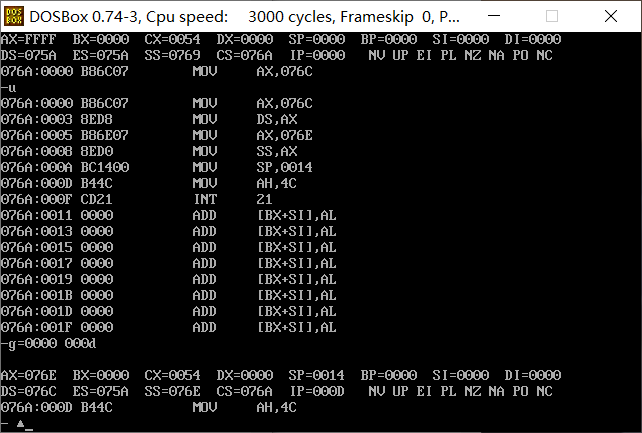
① In debug, execute until the end of line9 and before line11. Record this time: register (DS) =__ 076C__, Register (SS)=__ 076E__, Register (CS) =_ 076A_
② Assuming that the segment address of the code segment is X after the program is loaded, the segment address of the data segment is X__ X+2__, The segment address of stack is_ X+4__.
Tasks 1-5
① For the segment defined below, after the program is loaded, the actual memory space allocated to the segment is 16*ceil(N/16)
② task1_4.asm can still be executed correctly, because the entry of the original program is described after end. If it is empty, the program will be executed from scratch, only Task1_ The beginning of 4 is the content of the code segment.
Experimental task 2
Source code:
assume cs:code code segment start: mov ax,0b800h mov ds,ax mov bx,0f00h mov cx,80 s: mov [bx],0403h add bx,2 loop s mov ah, 4ch int 21h code ends end start
Experimental task 3
Source code:
assume cs:code data1 segment db 50, 48, 50, 50, 0, 48, 49, 0, 48, 49 ; ten numbers data1 ends data2 segment db 0, 0, 0, 0, 47, 0, 0, 47, 0, 0 ; ten numbers data2 ends data3 segment db 16 dup(0) data3 ends code segment start: mov ax,data1 mov ds,ax mov ax,data2 mov es,ax mov bx,0 mov cx,10 s: mov al,[bx] add es:[bx],al inc bx loop s mov ax,data3 mov ds,ax mov bx,0 mov cx,10 s0: mov al,es:[bx] mov [bx],al inc bx loop s0 mov ax,4c00h int 21h code ends end start
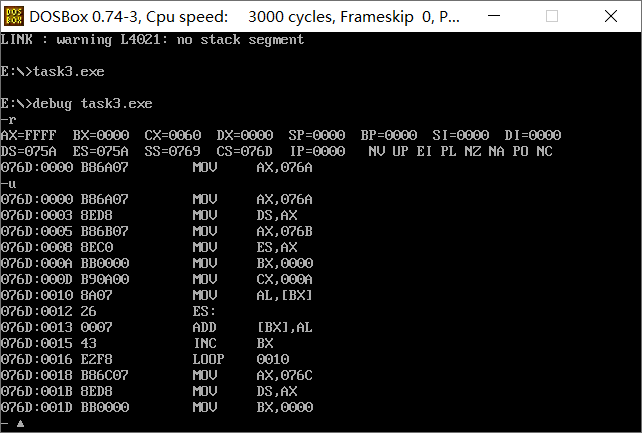
Initial state:

After execution:

Experimental task 4
Source code:
assume cs:code data1 segment dw 2, 0, 4, 9, 2, 0, 1, 9 data1 ends data2 segment dw 8 dup(?) data2 ends code segment start: mov ax, data1 mov ds, ax mov ax, data2 mov ss, ax mov sp, 16 mov bx, 0 mov cx, 8 s:push [bx] add bx, 2 loop s mov ah, 4ch int 21h code ends end start
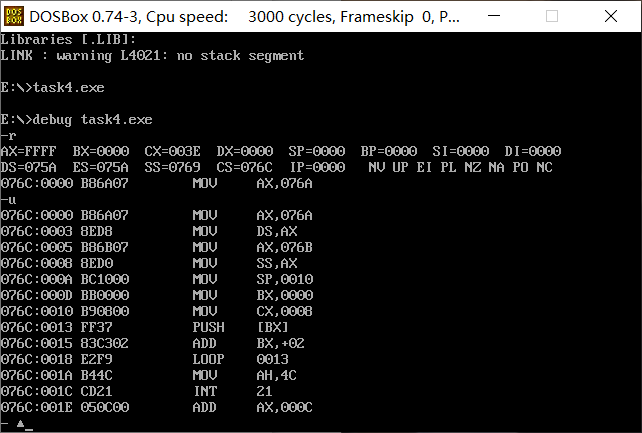
Before and after execution

Experimental task 5
Source code:
assume cs:code, ds:data data segment db 'Nuist' db 5 dup(5) data ends code segment start: mov ax, data mov ds, ax mov ax, 0b800H mov es, ax mov cx, 5 mov si, 0 mov di, 0f00h s: mov al, [si] and al, 0dfh mov es:[di], al mov al, [5+si] mov es:[di+1], al inc si add di, 2 loop s mov ah, 4ch int 21h code ends end start
Use the debug tool to debug the program, and use the g command to execute the screenshot before the program returns (i.e. after ine25 and before line27)
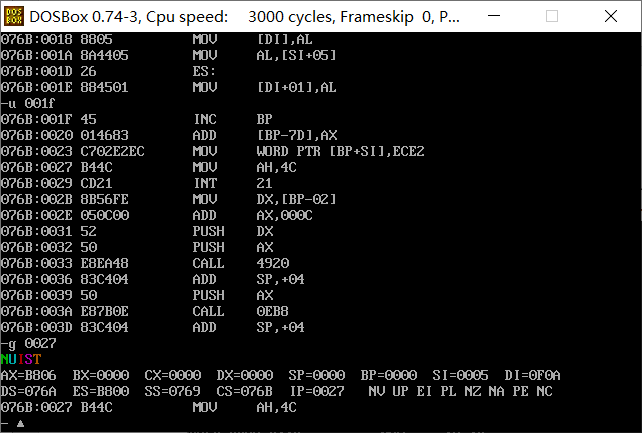
line15 set the number of cycles to 5, that is, the number of NUIST characters. Lines 16 and 17 set the initial values of the data segment and the video memory address offset respectively. Lines 18 and 19 copy the contents of the data segment into register ax and convert all characters into uppercase. Line 20 sends the value in register ax to the video memory address space, The last five bytes of the data segment in lines 21 and 22 are respectively sent to the cells adjacent to the first five characters in the video memory address space to set the color of each character.
Modify the value of 5 byte units in line4, reassemble, link, run and observe the results.


The values here are used to set the color of the displayed characters
Experimental task 6
Program source code:
assume cs:code, ds:data data segment db 'Pink Floyd ' db 'JOAN Baez ' db 'NEIL Young ' db 'Joan Lennon ' data ends code segment start: mov ax,data mov ds,ax mov cx,4 mov bx,0 s: mov dx,cx mov cx,4 mov si,0 s0: mov al,ds:[bx+si] or al,00100000B mov ds:[bx+si],al inc si loop s0 add bx,16 mov cx,dx loop s mov ah, 4ch int 21h code ends end start
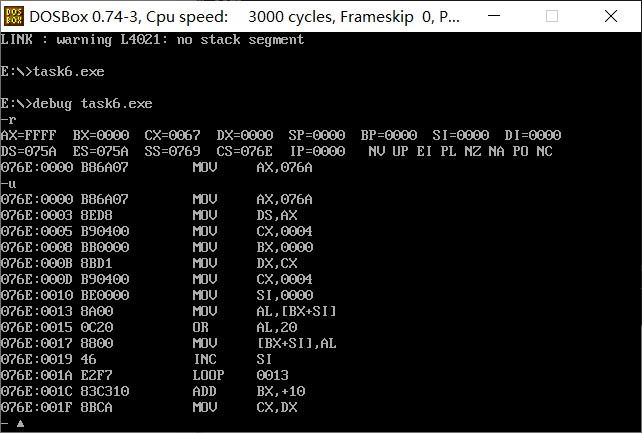
Before and after program execution:
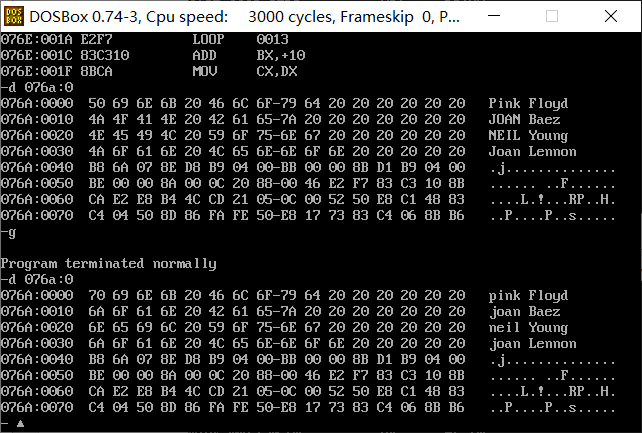
Experimental task 7
assume cs:code, ds:data, es:table data segment db '1975', '1976', '1977', '1978', '1979' dw 16, 22, 382, 1356, 2390 dw 3, 7, 9, 13, 28 data ends table segment db 5 dup( 16 dup(' ') ) ; table ends code segment start: mov ax, data mov ds, ax mov ax, table mov es, ax mov bx, 0 mov si, 0 mov cx, 5 s0:mov ax, ds:[bx] mov es:[si], ax mov ax, ds:[bx+2] mov es:[si+2], ax add bx, 4 add si,10h loop s0 mov bx, 20 ;Skip 20 bytes of year mov si, 5 mov cx, 5 s1:mov ax, ds:[bx] mov es:[si], ax mov word ptr es:[si+2], 0 ;The high address part of the revenue field is set to 0 add bx, 2 add si, 10h loop s1 mov cx, 5 mov si, 10 mov bx, 30 s2:mov ax, ds:[bx] mov es:[si], ax add bx, 2 add si, 10h loop s2 mov si, 0 mov cx, 5 s3:mov ax, es:[si+5] ;The lower 16 bits of the divisor are placed in ax in mov dx, es:[si+7] ;16 bit high, placed in dx in div word ptr es:[si+10] mov es:[si+13], ax ;Move quotient into position add si, 10h loop s3 mov ah, 4ch int 21h code ends end start


